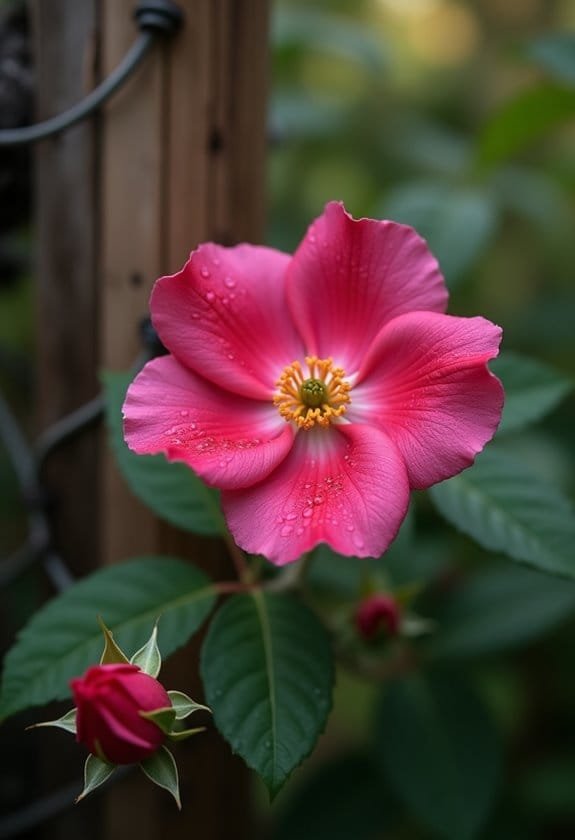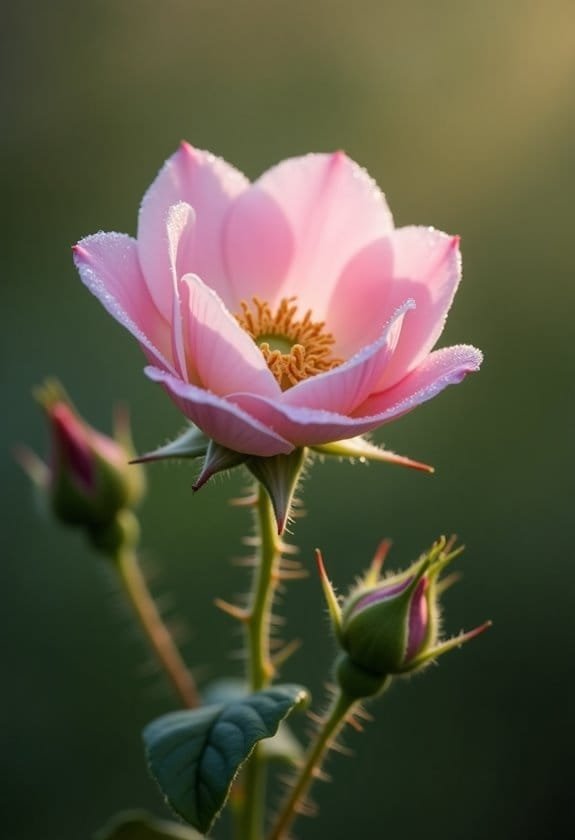The Dog Rose (Rosa canina) is a resilient climbing shrub reaching heights of 1-5 meters, distinguished by its gracefully arching stems and hooked prickles. It produces fragrant pink-to-white blossoms measuring 4-6 cm across, which bloom from June to July. This versatile species thrives in well-drained soils and requires at least 6 hours of daily sunlight, adapting well to temperatures between 60-75°F. The plant's vibrant red-orange hips, rich in Vitamin C, persist through winter and provide essential nutrition for wildlife. Its remarkable combination of ornamental beauty, ecological value, and historical significance makes it a fascinating subject for both casual gardeners and botanical enthusiasts.
Main Points
- Dog Rose (Rosa canina) is a climbing shrub reaching 1-5 meters tall with hooked prickles and pink to white flowers.
- The plant produces vibrant red-orange rose hips rich in Vitamin C, providing food for wildlife throughout winter.
- Native to Europe, Asia, and North Africa, Dog Rose thrives in well-drained soils and requires 6 hours of daily sunlight.
- Flowering occurs from June to July, with fragrant blooms measuring 4-6 cm across that attract pollinators like bees.
- Regular pruning in late winter, proper spacing, and consistent moisture support healthy growth and abundant flowering.
Introduction

The Dog Rose (Rosa canina), a resilient member of the Rosaceae family, stands as one of Europe's most widespread wild roses.
This climbing shrub commands attention with its gracefully arching stems that can reach heights of 1 to 5 meters, adorned with distinctive hooked prickles and delicate pink to white blossoms.
Native to Europe, parts of Asia, and North Africa, this versatile plant has earned its place in both ecological systems and human culture, offering sustenance to wildlife while providing valuable resources for traditional medicine and culinary applications.
Common Name
Known widely as Dog Rose, Rosa canina stands as one of Europe's most familiar wild roses, with additional common names like Briar Rose and Canker reflecting its cultural significance.
The origin of its primary common name has intriguing historical roots, stemming from ancient beliefs about its medicinal properties in treating canine-related ailments.
The designation "Dog Rose" has sparked considerable debate among botanical historians, with some suggesting it derives from the belief that the plant's root system could counter rabies in dogs.
Others propose that the name emerged from the plant's thorny nature, which can be as defensive and territorial as a guard dog protecting its territory.
The term has persisted throughout centuries of botanical documentation, becoming firmly established in both scientific literature and popular culture.
Throughout its native range in Europe, Asia, and North Africa, local communities have developed their own vernacular names for this species, though "Dog Rose" remains the most widely recognized designation in English-speaking regions, particularly in scientific and horticultural contexts.
Scientific Name
Identifying Dog Rose by its scientific name, *Rosa canina*, places it firmly within the diverse Rosaceae family, which encompasses over 300 species of roses worldwide.
This remarkable plant's taxonomic journey reflects the evolving understanding of botanical classification in the scientific community.
The species' complex genetic makeup is particularly remarkable, as it typically displays pentaploid characteristics, meaning it carries five sets of chromosomes. This genetic structure contributes substantially to the dog rose's adaptability and resilience across varied environments.
The plant's taxonomic history reveals interesting changes, including its former classification as *Cynorrhodon* before genetic studies in 2013 led to its current designation.
Scientists have documented several synonyms for *Rosa canina*, including *Rosa canina L. var. dumetorum Baker* and *Rosa corymbifera Borkh.*, highlighting the intricate nature of rose classification.
These variations in nomenclature demonstrate the ongoing refinement of botanical taxonomy, as researchers continue to uncover new relationships between different rose species through advanced genetic analysis and morphological studies.
Overview
Beyond its scientific classification, Dog Rose stands as one of Europe's most widespread and adaptable wild roses. This resilient shrub commands attention with its climbing habit, reaching impressive heights between 1 to 5 meters while employing sharp, hooked prickles for support and protection.
The plant's annual cycle showcases its remarkable versatility, beginning with a stunning floral display of pale to deep pink blooms that emerge during the summer months. These fragrant flowers, measuring 4 to 6 centimeters across, later transform into vibrant red-orange hips that persist through autumn and winter, offering sustained nourishment for local wildlife.
Dog rose demonstrates exceptional adaptability across diverse environments, thriving in USDA zones 3-7 and preferring sun-drenched locations with well-drained, nutrient-rich soils.
Its historical significance extends beyond ornamental value, as its vitamin C-rich hips have served both practical and therapeutic purposes throughout human history, from traditional medicine to survival food during times of scarcity, cementing its place as a plant of both ecological and cultural importance.
Key Features
The Dog Rose stands as a robust deciduous shrub, reaching impressive heights between 1 to 5 meters with its thorny climbing stems creating natural barriers in wild landscapes.
Its pinnate leaves showcase 5 to 7 aromatic leaflets that release their distinctive fragrance when damaged, contributing to the plant's sensory appeal.
The shrub bursts into bloom from June through July, displaying large flowers that measure 4 to 6 centimeters across and range from pristine white to various shades of pink, creating a spectacular summer display.
Growth Size
Climbing and sprawling through woodland areas, Rosa canina reaches impressive heights of 1-5 meters (3.3-16.4 feet) as a deciduous shrub. This dog rose's remarkable vertical growth is facilitated by its distinctive hooked prickles, which act as natural grappling hooks, allowing the plant to secure itself to surrounding vegetation and structures.
The shrub's expansive growth pattern extends both vertically and horizontally, creating a substantial presence in its habitat. While the main stems establish the plant's primary framework, numerous lateral branches emerge, forming a complex network of growth that can span considerable distances when provided with adequate support.
The plant's scrambling nature enables it to weave through the canopy of taller trees, often resulting in a cascade of foliage and flowers visible at various heights.
The pinnate leaves, arranged in groups of 5-7 leaflets, contribute to the plant's overall volume, creating a dense vegetative mass that can dominate its growing space. This vigorous growth pattern, combined with the plant's ability to establish itself in various environments, makes it a significant presence in both natural and cultivated settings.
Appearance
Striking in appearance, Rosa canina displays several distinctive features that make it easily recognizable in the wild. The shrub's most notable characteristic is its array of small, sharp, hooked prickles that serve dual purposes: facilitating its climbing behavior and providing natural defense against herbivores.
The plant's foliage presents an elegant arrangement of pinnate leaves, featuring five to seven aromatic leaflets that release their signature fragrance when damaged or crushed.
During the summer months of June and July, dog roses produce their most enchanting display as delicate blooms emerge, spanning 4 to 6 centimeters in diameter and exhibiting hues that range from pristine white to various shades of pink.
Perhaps most dramatic is the transformation that occurs in autumn, when the shrub adorns itself with vibrant red-orange hips measuring 1.5 to 2 centimeters.
These eye-catching fruits persist through the winter months, creating striking visual interest long after other plants have shed their foliage, and serving as natural ornaments against the winter landscape.
Flowering Season
Blooming across hedgerows and woodland edges, Rosa canina bursts into life during the warm months of June and July. The flowering season showcases delicate blossoms measuring 4-6 centimeters in diameter, each displaying five perfectly arranged petals in hues ranging from pristine white to deep pink.
During this vital period, the Dog Rose's flowers emit a subtle sweet fragrance that serves as nature's invitation to essential pollinators. Bees and butterflies are particularly drawn to these aromatic blooms, facilitating the plant's reproductive cycle through their foraging activities.
The flowering process reaches its peak when the plant receives abundant sunlight, demonstrating the species' preference for well-illuminated locations.
The flowering season concludes with a remarkable transformation as the blossoms give way to vibrant red-orange hips. These fruits, maturing from September to October, persist through the colder months as living testimony to successful pollination.
Rich in Vitamin C, these hips represent the culmination of Rosa canina's flowering cycle, highlighting the intricate relationship between seasonal changes and the plant's reproductive strategy.
Growing Requirements

Dog Rose thrives in full sunlight and adapts remarkably well to various soil conditions, particularly favoring well-drained, humus-rich environments that retain adequate moisture.
The plant demonstrates impressive hardiness across USDA zones 3 to 7, withstanding maritime conditions and heavy clay soils while requiring protection from waterlogged situations and deep shade.
For ideal growth and flowering, Rosa canina benefits from consistent moisture during its growing season, though established plants show considerable drought tolerance and can flourish with minimal intervention in temperatures ranging from -37°C to 32°C (-35°F to 90°F).
Light
The growing requirements for Rosa canina emphasize its strong need for direct sunlight, with at least 6 hours of daily exposure necessary for peak growth and flowering.
Like many flowering shrubs, the dog rose transforms sunlight into essential energy through photosynthesis, which fuels its impressive display of blooms and subsequent fruit production.
While Rosa canina demonstrates remarkable adaptability to various growing conditions, its relationship with light proves particularly important for best development.
In shaded locations, the plant's flowering capability diminishes considerably, resulting in reduced fruit production and less vigorous growth.
The shrub's natural preference for open, sunny positions reflects its evolution in meadows and woodland edges, where it can harness maximum solar exposure.
For gardeners cultivating this versatile species, selecting an appropriate planting site becomes paramount to success.
The combination of full sun exposure and well-draining soil creates perfect conditions for the plant to thrive, allowing it to reach its full potential in both ornamental value and fruit yield.
Insufficient light not only impacts blooming but can also lead to leggy growth and reduced overall energy.
Soil
Although Rosa canina adapts to various soil conditions, it flourishes best in well-drained, humus-rich environments that maintain consistent moisture levels. The dog rose demonstrates remarkable versatility in its ability to establish itself in different soil types, including heavy clay compositions, while maintaining robust growth patterns.
While this resilient shrub shows considerable adaptability, it's crucial to avoid planting in locations where water tends to accumulate or in extremely arid conditions that can't sustain proper moisture retention.
The ideal soil pH for Rosa canina falls within the neutral to slightly acidic range, though this isn't a critical factor for its survival. To enhance soil quality and promote ideal growing conditions, applying a generous layer of organic mulch during late winter or early spring proves particularly beneficial. This practice not only helps maintain consistent soil moisture levels but also gradually improves the substrate's overall structure and nutrient content.
Gardeners should ascertain that while the soil retains adequate moisture for healthy root development, it shouldn't become waterlogged, as this can lead to root rot and compromise the plant's long-term health.
Water
Maintaining proper water balance plays a central role in successfully growing Rosa canina. The plant requires consistent moisture levels throughout its growing season, yet demonstrates remarkable adaptability to varying conditions when managed correctly. During spring and summer months, regular watering becomes essential to support the development of both flowers and fruits.
While Rosa canina shows resilience in different environments, its relationship with water requires careful attention. The shrub thrives in well-drained soils that retain moisture without becoming waterlogged, as excessive water can impede flowering and fruit production.
During dry spells, supplemental watering helps maintain ideal growing conditions, particularly when the plant is establishing its root system or preparing to bloom. Strategic mulching around the base of the plant serves as an effective moisture-retention strategy, creating a balanced hydration environment that supports healthy growth.
Gardeners should monitor soil moisture levels regularly, adjusting watering schedules based on seasonal changes and local climate conditions. This attention to water management guarantees the Dog Rose maintains its vigorous growth while preventing the stress that can occur from either drought or oversaturation.
Temperature
Throughout its natural range, Rosa canina exhibits remarkable adaptability to varying temperature conditions, flourishing particularly well in hardiness zones 3-7. The dog rose demonstrates excellent growth and development when temperatures remain between 60°F to 75°F (15°C to 24°C) during the active growing season, creating an ideal environment for robust flowering and fruit production.
This resilient species has evolved to withstand significant temperature fluctuations, making it a versatile choice for temperate climate gardens. During winter dormancy, Rosa canina's hardy nature allows it to endure considerably colder temperatures without sustaining lasting damage to its crucial structures.
The plant's temperature tolerance is complemented by its ability to adapt to different light exposures, from full sun to partial shade, which influences its local temperature requirements.
While the dog rose shows impressive cold hardiness, it's important to note that prolonged exposure to temperatures outside its preferred range may affect blooming intensity and overall vigor. In regions experiencing extreme temperature variations, strategic placement in sheltered locations can help moderate temperature stress and promote excellent growth patterns.
Pollinator Criteria
The Dog Rose attracts an impressive array of pollinators, with honeybees, butterflies, and beneficial insects drawn to its abundant nectar and pollen reserves during the peak flowering months of June and July.
The plant's vibrant flowers and aromatic fragrance act as natural beacons, broadcasting signals that guide pollinators toward their nutritious rewards.
These pollinator interactions guarantee successful reproduction, leading to the formation of rose hips that serve a dual purpose as both seed carriers and valuable food sources for local wildlife.
Attracted Pollinators
During summer months, Dog Rose flowers attract an array of essential pollinators through their distinct features and abundant resources. The plant's delicate pink to white blooms, which emerge between June and July, serve as beacons for diverse pollinating insects seeking sustenance during peak activity periods.
The dog rose's ability to draw pollinators stems from its carefully orchestrated combination of visual and olfactory attractions. Its fragrant flowers release enticing scents that guide bees and butterflies to their nectar-rich centers, while the vibrant petals provide clear visual signals that facilitate efficient pollinator navigation. These characteristics make Rosa canina particularly effective at supporting local pollinator populations throughout the growing season.
Beyond immediate pollination benefits, the plant's ecological contributions extend through multiple seasons. The resulting rose hips provide vital nutrition for birds and wildlife, creating a sustainable ecosystem that indirectly supports pollinator communities.
Additionally, the structural complexity of Dog Rose within hedgerows and woodland margins offers essential shelter and nesting sites, establishing microhabitats that enhance overall pollinator diversity and abundance.
Pollination Method
Several key adaptations in Rosa canina's flower structure enable highly effective pollination across diverse insect species. The plant's distinctive cup-shaped blooms feature an open architecture that provides unrestricted access for visiting pollinators, while numerous stamens create an abundant pollen source for successful reproduction.
During its peak flowering period in June and July, Rosa canina's pollination strategy aligns perfectly with the seasonal activities of various beneficial insects. The flowers' sophisticated design includes strategically positioned nectar glands that reward pollinators while ensuring they brush against the pollen-laden stamens during their foraging activities. This careful evolutionary arrangement maximizes cross-pollination efficiency between different Dog Rose plants.
The plant's pollination success relies heavily on its ability to attract multiple pollinator species through a combination of visual and chemical signals. As insects move between flowers collecting nectar and pollen, they serve as crucial carriers of genetic material, facilitating the reproduction process that maintains healthy Rosa canina populations throughout their natural range.
This intricate relationship between flower structure and pollinator behavior demonstrates nature's refined approach to ensuring species continuation.
Care & Maintenance

Dog roses thrive in sunny locations where they can be planted in well-drained, humus-rich soil with adequate spacing of 144 inches between specimens to promote ideal growth and air circulation.
Regular maintenance includes pruning in late winter or early spring, which helps shape the shrub and encourages robust flowering, while applying a thick layer of mulch around the base supports moisture retention and weed control.
These hardy shrubs work well alongside other drought-tolerant plants and can be paired with complementary species like elderberry or hawthorn, which share similar growing requirements and create a naturalistic hedgerow setting.
Planting Tips
When establishing a Dog Rose (Rosa canina), proper planting and maintenance are essential for its long-term success. This resilient shrub thrives in locations that receive full sunlight exposure, though it demonstrates remarkable adaptability to various soil conditions.
For ideal growth, gardeners should space Dog Rose plants approximately 3.7 meters apart, allowing sufficient room for their impressive potential height of up to 5 meters. The soil preparation process requires creating a well-draining environment enriched with humus, which provides essential nutrients for robust development.
While Rosa canina can tolerate poor soil conditions, investing in proper soil preparation will yield superior results.
After planting, implementing a consistent maintenance routine proves vital for the plant's establishment. This includes applying a protective layer of mulch during late winter or early spring, which serves the dual purpose of moisture retention and weed suppression.
During dry periods, maintain consistent soil moisture without oversaturating, as waterlogged conditions can compromise root health. Regular pruning sessions help shape the plant while promoting vigorous growth and ensuring proper air circulation throughout the shrub's structure.
Ongoing Care
Maintaining a healthy Dog Rose requires three fundamental care practices throughout the growing season. First, regular pruning in early spring promotes vigorous growth and abundant flowering, setting the stage for the Rosa canina's spectacular June-to-July bloom period.
Second, applying a generous layer of mulch during late winter or early spring helps retain essential soil moisture and enhances the plant's overall vitality.
Ongoing care for Dog Rose involves vigilant monitoring for common threats that can compromise plant health. Gardeners should regularly inspect for aphids and leafhoppers, which can damage foliage, while also watching for signs of rose rust or powdery mildew developing on the leaves.
These fungal diseases require prompt treatment to prevent spread and maintain the plant's robust nature. To guarantee ideal growth conditions, Dog Roses should be spaced approximately 144 inches apart, allowing sufficient air circulation between specimens.
While Rosa canina demonstrates remarkable resilience in poor soil conditions, providing well-drained, humus-rich soil and full sun exposure will reward gardeners with healthier plants and more abundant blooms throughout the growing season.
Suggested Companions
Successful companion planting enhances the beauty and importance of Rosa canina while creating a harmonious garden ecosystem. The dog rose thrives alongside aromatic herbs like lavender and sage, which share its preference for sunny locations and well-drained soil conditions.
These complementary plants not only create an aesthetically pleasing arrangement but also attract essential pollinators to the garden space. Native wildflowers make excellent companions for Rosa canina, contributing to the garden's biodiversity and providing sustained nectar sources for beneficial insects and wildlife throughout the growing season.
When planning the garden layout, maintaining proper spacing of 3 to 5 feet between Rosa canina and its companions is vital for ideal growth. Low-maintenance perennials work particularly well with the dog rose's pruning schedule, as both benefit from late winter or early spring maintenance.
The addition of mulch around Rosa canina and its companion plants serves multiple purposes, including moisture retention and weed suppression, creating an environment where all plants can flourish together. This thoughtful combination of plants promotes a self-sustaining garden ecosystem that requires minimal intervention while maximizing benefits for both flora and fauna.
Are Goat Willow and Dog Rose Similar in Their Uses for Wildlife and Habitat Support?
Goat willow salix caprea tree and Dog Rose are both invaluable for wildlife and habitat support. While the goat willow provides early nectar for bees and shelter for bird nests, the Dog Rose offers vibrant hips, feeding birds and mammals. Together, they enhance biodiversity in natural ecosystems.
Common Issues
Dog roses face several significant pest and disease challenges, including the distinctive orange pustules of rose rust and the telltale white coating of powdery mildew on their foliage.
Various insects, from tiny aphids to persistent scale insects, can compromise the plant's health by feeding on leaves and stems, causing distortion and weakening the overall structure.
Fortunately, regular monitoring combined with proper cultural practices, such as maintaining adequate spacing between plants and ensuring good air circulation, can help gardeners identify and address these issues before they become severe problems.
Pests/Diseases
The wild dog rose faces several significant pest and disease challenges that can impact its health and appearance. Among the most troublesome pests are aphids, leafhoppers, and scale insects, which actively weaken the plant by feeding on its sap and diminishing its overall vigor.
Disease management becomes particularly important as Rosa canina can fall victim to destructive fungal infections, including rose rust and powdery mildew, which manifest through telltale leaf discoloration and stunted growth patterns.
The plant's vulnerability extends to persistent threats from caterpillars and the specialized rose leaf-rolling sawfly, whose feeding activities can severely compromise the shrub's aesthetic value and photosynthetic capabilities.
Successful pest management relies heavily on vigilant monitoring and early detection, with gardeners needing to watch for warning signs such as curled leaves and the sticky honeydew residue characteristic of aphid infestations.
Fortunately, environmentally conscious solutions exist through the implementation of organic pest control strategies, including the introduction of beneficial predatory insects and the application of gentle yet effective insecticidal soaps, which help maintain the plant's natural defense systems.
Solutions
Managing common issues in Rosa canina requires a multi-faceted approach that combines preventive care with targeted solutions.
Gardeners can effectively control disease outbreaks through strategic spacing of plants at 144 inches apart, which promotes ideal air circulation and reduces the likelihood of fungal infections taking hold.
For combating powdery mildew and rose rust, a combination of proper cultural practices and targeted fungicidal treatments proves most effective.
When dealing with insect infestations, the introduction of beneficial predators serves as a natural defense mechanism, while regular monitoring allows for early detection and intervention.
Gardeners should inspect plants frequently for signs of aphids, scale insects, and leafhoppers, removing affected foliage promptly to prevent further spread.
Root health can be maintained through careful soil preparation and management.
Creating well-draining, humus-rich growing conditions helps prevent root rot and other moisture-related problems that commonly affect Rosa canina.
For propagation purposes, taking hardwood cuttings in autumn provides an excellent opportunity to establish new, healthy plants while maintaining appropriate spacing for disease prevention.
Summary

Widely known as Dog Rose, Rosa canina stands as a hardy deciduous shrub characterized by sharp hooked prickles and fragrant pinnate leaves. This remarkable plant, which can reach heights of 1 to 5 meters, produces delicate flowers ranging from pale to deep pink or white during its summer blooming period from June to July.
The ecological significance of Dog Rose extends beyond its aesthetic appeal, as it serves as an essential resource for pollinators and provides sustenance for various wildlife through its vitamin C-rich hips. Its adaptability to different soil conditions and ability to thrive in USDA zones 3-7 makes it an excellent choice for hedgerows and woodland edges, where it contributes to soil stabilization.
The historical importance of this versatile plant is evidenced by its cultivation in WWII victory gardens, where it was valued for its nutritional benefits.
Today, Dog Rose continues to play a multifaceted role in modern applications, from culinary uses to herbal remedies, demonstrating its enduring relevance in both ecological systems and human utilization.


